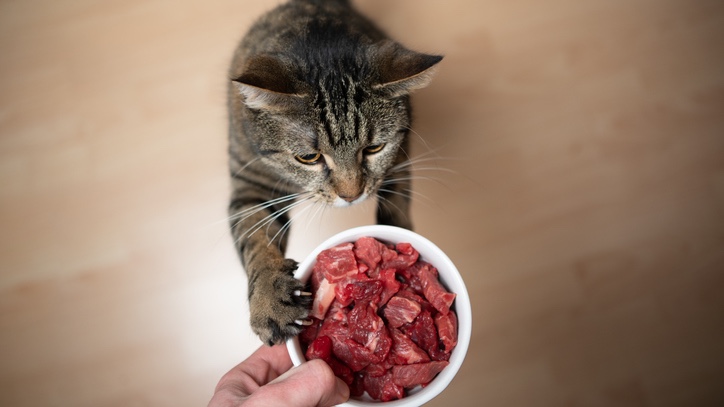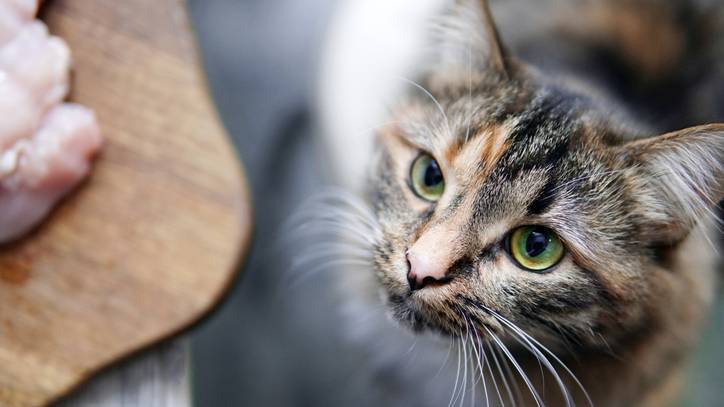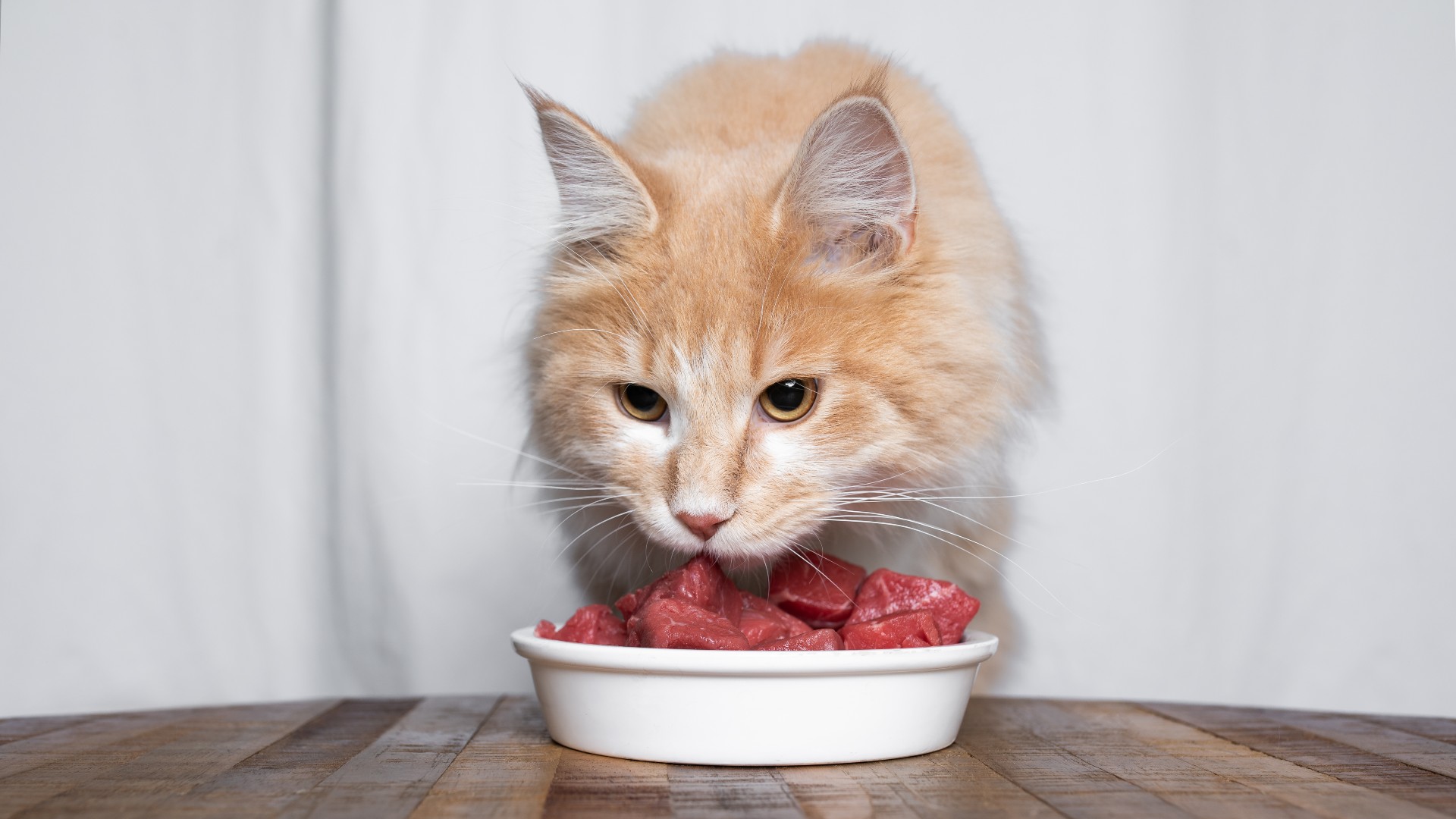How to make homemade raw cat food: Risks, cost and what to check
When discovering how to make raw cat food, there are some things to bear in mind

When asking how to make homemade raw cat food, there's a key point to bear in mind: cats are obligate carnivores so they can't be a vegetarian let alone a vegan!
Therefore, when discussing the best raw cat food and how to make it, we're talking meat, meat, meat! It's essential to a cat's survival because they obtain glucose from the protein and, in the absence of meat, a kitty's body will look elsewhere for its protein fix, usually breaking down a kitty's organs and muscle instead.
Yet there's also a second question aside from how to make raw cat food and that's "should I make raw cat food?". You definitely have to think long and hard before you take the plunge, not only because it requires more effort but because you need to get it right too.
After all, when you feed a moggy with the best cat food, you can rest assured that you're giving your furbaby a balanced diet with all of the vitamins and nutrients they need to thrive.
They also contain meat products which means they'll have a source of taurine – essential for the health of their heart and eyes – as well as lots of protein. In making your own raw alternative, you need to match this expertise!
Can you make raw cat food at home?
Before we begin to tackle the ins and outs of making bespoke meals for your cat, you may be interested to know that you can give your kitty the best raw cat food by simply going into a shop and buying it in a packet.
But if you want to make raw cat food at home, then yes, that is absolutely possible so long as you're aware a cat needs animal protein, amino acids such as arginine and taurine, fatty acids, vitamins (particularly A and D), minerals and water.
There's just one more step to take prior to that: go visit a vet. It's always a good idea to get your cat checked out and assessed for any potential dietary problems and if you have some recipes in mind, then write them down and take them along. A veterinary nutritionist will look at them and help create a recipe that meets your individual cat's nutritional needs. This typically depends on a kitty's lifestyle, age and health.
One thing's for sure, it's never a case of slapping some meat on a bowl and placing it on the floor. While there are indeed many benefits of raw cat food, you still have to ensure your cat is getting a balanced diet and that means faithfully sticking to any recipe you're given as if your cat's life depends on it – because, in many ways, it does.
You can't poke around the fridge, realize you don't have an ingredient and swap it out because that will alter the balance of the food you're giving.

Is it cheaper to make raw cat food?
A lot depends on what you're comparing raw cat food to. If you're looking to replace a premium wet cat food or dry cat food with a raw food recipe then you may find it's a little bit cheaper, but if you're comparing raw with a budget buy, then it's very likely to be more expensive.
It all comes down to the quality of the ingredients you'll be using. Since most pet owners who switch to raw cat food are doing so on health grounds, there's a good chance you'll want to buy good quality meat. There are ways of keeping the costs down such as buying meat in bulk, going for less expensive cuts or watching out for discounts, but factor in the cost of extras such as eggs, salmon oil, vitamins and amino acids.
Don't forget that time is money too! You could whip up a cat's meal in seconds if you buy off-the-shelf, but you're going to be spending much longer than that on a raw food diet. As a basic rule, though, the cost of making your own meals for a kitty is generally comparable to the cost of buying a mid-range meal from a supermarket.
What can cats eat in a raw diet?
In general, the ingredients needed for a raw diet are simple. You will require raw muscle meat such as chicken, fish and beef as well as organ meat, ground bones, cooked eggs, supplements and a source of fiber. Your vet will advise you on portion size.
Whatever you do, however, don't give cats dairy products such as milk or cheese, keep them away from garlic, onions and chocolate and only give liver sparingly. Tuna for human consumption should also be avoided.
How to make raw cat food without a grinder
Making raw cat food entails preparing the meat by removing any skin and either cutting it into chunks or placing it in a meat grinder. You then need to create a supplement out of cooked egg yolk, salmon oil, water and various supplements, whisking them together into a sauce to ensure your cat gets sufficient moisture and a balanced diet.
Investing in a meat grinder is therefore recommended and if you're going to be making raw cat food on a regular basis then it'll definitely make your life easier – more so if you have a powerful machine that will make light work of any bones.
If you don't have a grinder, you could try a blender or food processor. Otherwise, ask a butcher to help, or opt for boneless meat, being sure to add a bone substitute. Cut up the meat on a large clean cutting board and make sure you have some scales handy so that you stick to the required weight. If you have lots of leftovers, package them up and pop them in a freezer, being sure to defrost the food properly before serving.

Health risks of raw cat food
One of the biggest risk is not giving your cat a balanced diet. So many people go online looking for a recipe or scour magazines for inspiration but this isn't the right way to go about it. A raw cat food diet has to be right for your kitty and you need recipes that are individually tailored.
If you do tread the correct path, however, there are still some health risks to consider. Aside from the potential of bones causing gut and dental issues, there is a risk of bacteria such as Salmonella and E.coli forming on raw meat, along with Listeria monocytogenes Campylobacter, Clostridium difficile, C. perfringens, C. botulinum, Yersinia enterocolitica and enterotoxigenic Staphylococcus aureus.
Such bacteria poses a risk to humans, too, so keep all surfaces clean, ensure the meat is well away from other food and keep meat frozen until you're ready to use it. You should also be wary of switching to a raw cat food diet for a moggy if you have very young children, elderly people or anyone with a chronic health condition living in your home.
You can also learn how to make cat treats at home. If your cat won't eat wet food, read our helpful guide for advice.
PetsRadar Newsletter
Get the best advice, tips and top tech for your beloved Pets

David Crookes has been a journalist for almost 30 years and he has written for a host of magazines, newspapers, websites and books including the World of Animals Annual, BBC Earth, Live Science, The Independent and Tom’s Guide.
Born in England, he lives with two cats but he’s also keenly interested in the differences between the huge number of dog breeds – in fact, you can read many of his breed guides that he’s written in collaboration with vets here on PetsRadar.
With a lifelong passion for technology, too, he’s always on the lookout for useful devices that will allow people to keep their pets happier and healthier, and provide them more time to spend together.
David has a degree from Durham University, as well as postgraduate diploma in journalism from the University of Central Lancashire.
